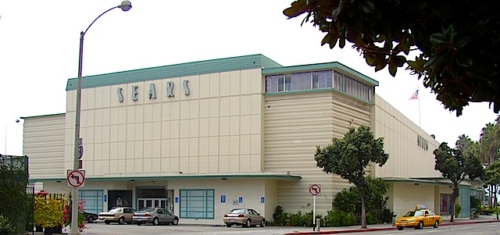Sears Roebuck Store

- Known As
- Streamline Moderne, Art Deco
- Architect
- Rowland H. Crawford
- Built
- 1946
- Designated
- 2005
The Sears store, built just after World War II at 302 Colorado Avenue, is significant on several accounts. First, the building is an outstanding example of late Streamline Moderne architecture.
Streamline Moderne was a phase of Art Deco that became popular in the 1930s and bridged the war years to remain influential through the 1940s. The Sears building exhibits many elements typically associated with the style including an emphasis on the horizontal, seen in the parallel, grooved patterns on the building’s corners, the slender curved canopies that shade each entrance, and the horizontally-striated parapet that tops the building.
The neon Sears signs that grace the building are rendered in typically stylized period lettering. Other Moderne details include two sculptures on the Colorado façade of the store in which idealized pairs of ordinary people (note the period hairstyles) gaze confidently into the distance, supported by stylized waves.
As a late Moderne structure, the Sears building is interesting because it also suggests the growing influence of the International style—a movement that would come to dominate architecture in the mid-20th century—in its repetition of simple geometric forms (as in the square pattern on the east façade), use of metal window frames, tendency towards angularity, and reliance on concrete and steel as structural materials. The building is an especially valuable example of late Streamline Moderne because it has been altered very little since its construction.
Sears is also notable as the work of architect Rowland Crawford. Crawford began working in Los Angeles with the well-known firm of Gordon B. Kaufmann in the 1930s. He then went on to open his own firm in 1938, based in Beverly Hills. Crawford is best remembered for skillfully marrying elements of Moderne style with aspects of International style in projects that included the Times-Mirror Building in downtown Los Angeles.
Sears has a place in history as one of many department stores that opened in the years immediately after World War II to capitalize on the pent-up consumer demand unleashed once the war ended. (In its first ten minutes of business in 1947, more than 2,000 customers surged into the store and forty police officers were needed to control the crowd.) The building is also remarkable in that it dates from the brief period of department store design which featured both pedestrian orientation, via a main entrance off Colorado, and automobile orientation, via ample free parking and entrances off the parking lots. Moreover, in the late 1940s Sears was the scene of one of Santa Monica’s earliest civil rights demonstrations. The demonstration took place when local activists and the NAACP picketed the store to demand equal hiring of African-Americans. The Sears building is also unusual in that it still fulfills its original function as a department store. Indeed, Sears has the distinction of being the only large business in Santa Monica’s downtown area in operation continuously since 1947.
Sources:
- Cyril M. Harris. American Architecture: An Illustrated Encyclopedia. New York: W.W. Norton, 1998.
- Carole Rifkind. A Field Guide to American Architecture. New York: Plume Books, 1980.
- Santa Monica Historical Resources Inventory, 1985-1986. Vol. 6. City of Santa Monica, Building and Safety Department.
- Paula A. Scott. Santa Monica: A History on the Edge. Charleston SC: Arcadia Publishing, 2004.
- Staff Report on Sears Roebuck Store, 302 Colorado Avenue. City Planning Division, Santa Monica.